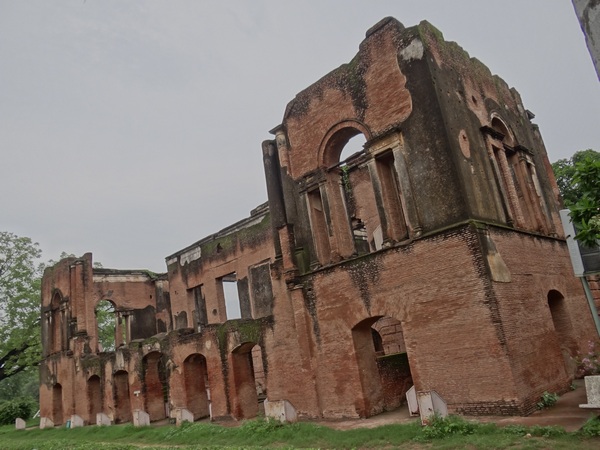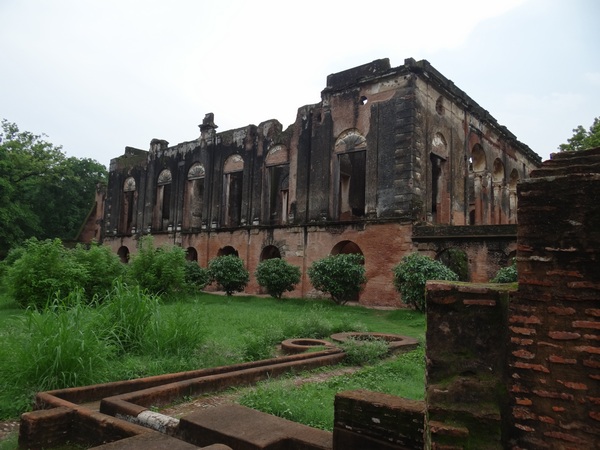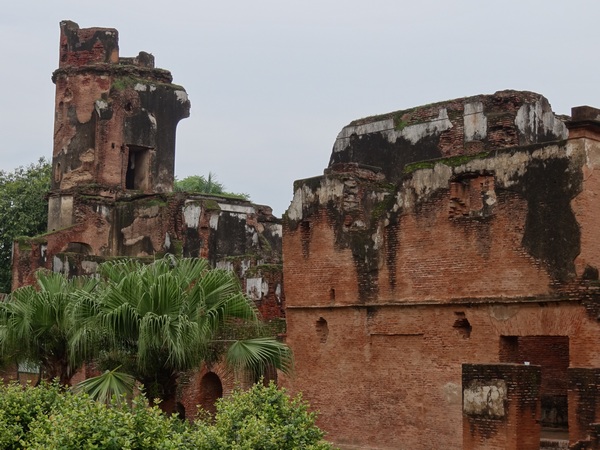Photographs: Nirdesh K Singh Nirdesh K Singh
After his articles on the Chitradurga Fort, Daulatabad Fort and the Bada Imambara, Rediff reader Nirdesh K Singh sends in this story of Lucknow's famed Residency.
On May 1, 1857 East India Company's sepoys belonging to 7th Oudh Irregular Infantry refused to bite the cartridges of the newly introduced Pattern 1853 Enfield Rifle Musket.
The cartridges were allegedly greased with beef and pork fat. The musket drill involved biting the cartridge that violated sepoys' religions.
It did not help that the Company had recently annexed Awadh on the grounds of mal-administration and duly externed Nawab Wajid Ali Shah to Calcutta.
On May 10, sepoys in Meerut revolted and marched to Delhi. First War of Indian Independence had started.
When Sir Henry Lawrence, the Chief Commissioner of the state of Awadh heard this, he summoned loyal infantry men and sepoys for the defence of the Residency. Residency was a group of buildings originally built in 1800 by Nawab Saadat Ali Khan and then served as the residence of the Chief Commissioner who was British representative in the court of the Nawab.
British from neighbouring districts fearing for their safety started arriving in Residency to take refuge. Lawrence also started building defences and stocking up on ammunition and supplies. Rebellions broke out in neighbouring Sitapur, Sultanpur and Faizabad. Nana Sahib led the mutiny in Kanpur.
Exactly 155 years ago, on a beautiful rainy day just like today, the light rain fell on the delicate blades of green grass. The gentle pitter-patter of the rain drops is shattered with the boom of canon shells and bang of musket shots. The date was June 1857 -- The Residency was under siege.
At that time the Residency housed about 1700 fighters of which 700 were Indian. There were also about 1800 non combatants including 600 women and children.
The total number of inhabitants inside the Residency was about 3500. The strength of sepoys in the beginning was about 6000.
The mutineers dug in with field guns, canons and muskets. The siege lasted for about five months. Two relief attempts were made by the British forces. The heat and rains with associated diseases took terrible toll on the defenders and the besieging mutineers.
IN PICS: The story of the tragedy of Lucknow's Residency
Image: The scene of the tragedy stands in solemn silence todayPhotographs: Nirdesh K Singh
It is said savage hand to hand combats with bayonets, axes and shovels were fought on the ground and in the tunnels dug by mutineers under the Residency.
The ferociousness of the siege can be gauged from the fact that 24 Victoria Crosses were awarded on the final day of the Second Relief. I am not sure if there were any Indian recipients from British side.
On this day, Scottish Highlanders and Punjab Infantry from the British Army stormed the Secundra Bagh. It is said about 2000 mutineers were slaughtered on this day and were believed to be buried in the grounds. However, an iconic photo by Felice Beato taken few months after the siege showed skulls and human remains spread on the grounds.
At the end of the Second Relief, the mutineers were defeated and the Residency was finally evacuated. Only 1000 refugee inhabitants survived the siege. Lawrence died due to shrapnel injuries on July 4 in the initial days but the siege produced more British heroes like Outram, Havelock and Campbell.
Since the history has been written by the British, research could not dig out any Indian names from mutineers' side connected to the Residency siege. Of course, the First War of Independence produced heroes like Mangal Pandey, Nana Sahib, Tatya Tope and Rani of Jhansi.
Their heroic tales share history with equally ignominious treachery and betrayal tales at the hands of their own people.
The mutiny in Lucknow though suppressed, laid the ground for future struggles for Independence. Even though the mutineers numbered about 40000, the major reason for failure of the rebellion was attributed to the absence of unified command that could coordinate the attacks.
The sepoys also happened to be ill-disciplined and acted more like a mob with no planning. While the British army was disciplined and superior militarily. The educated middle class did not join the mutiny as they believed British rule would help in modernisation of the country.
IN PICS: The story of the tragedy of Lucknow's Residency
Image: The destroyed observatoryPhotographs: Nirdesh K Singh
As you enter the main gate of Residency, the din of Lucknow city recedes until just the distant hum of traffic remains. It is a quite green oasis in the middle of cacophony that Lucknow is today.
The pervading hush makes it hard to believe that this eerily quite place was witness to one of the bloodiest fights of Indian Mutiny of 1857. This is nature's way of soothing the Residency with eternal balm and tranquillity to anesthetize the tumultuous past. The dewy green grass absorbs the shock of looking at the cannon scarred red brick walls.
Most of the buildings are heavily damaged with few having roofs.
Barring the green grass, it seems that the siege ended just yesterday. The shattered walls carry the echoes of tragedy, doom, valour, disease and gore. Walk the grounds and you are immediately transported to those turbulent days. Residency is a sprawling compound with neat manicured gardens.
Signs indicate the names of various buildings. During the rains, the green moss covering the red brick broken walls lends an exquisite charm to the place. Spend some time in the museum. The church's cemetery has the graves of about 2000 people including Lawrence. Visit Nawab Saadat Ali Khan's Tomb. Stay back for the light and sound show in the evening.
IN PICS: The story of the tragedy of Lucknow's Residency
Image: The circle of life completes itself. A flower blooms amidst the ruinsPhotographs: Nirdesh K Singh
The Residency is a story of valour, courage and determination from both sides. Indians for the first time put up a brave effort to overthrow the Company. The Britishers on the other hand fought for their imperialistic prestige and to save the lives of people inside Residency.
At the end of the mutiny, East India Company was disbanded and India was ruled directly by the British Crown. It is reported that the Union Jack fluttering over The Residency was never lowered -- even at sunset. The display of the flag was so important to the British psyche that when India's independence was few hours away, the flag was carted off only to be unfurled on Windsor Castle.
Getting there: The Residency lies quite and mourning in the heart of Lucknow city.





Comment
article